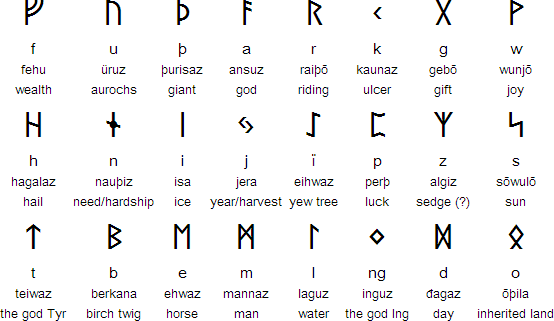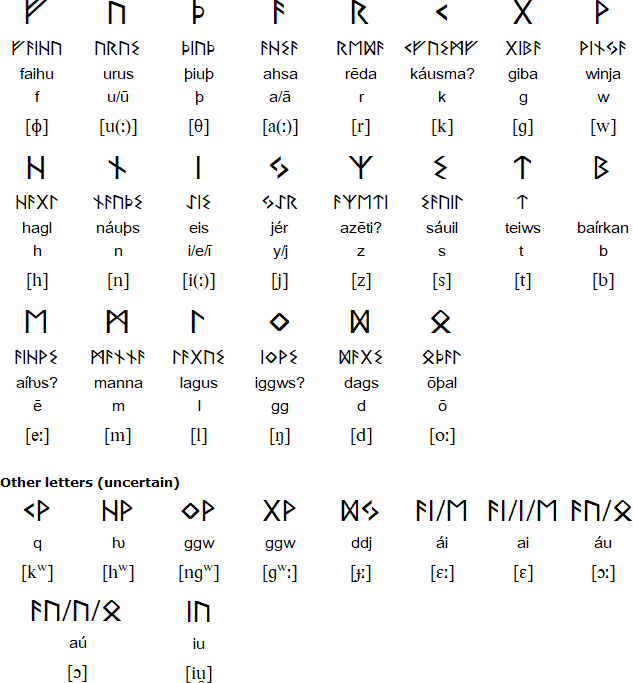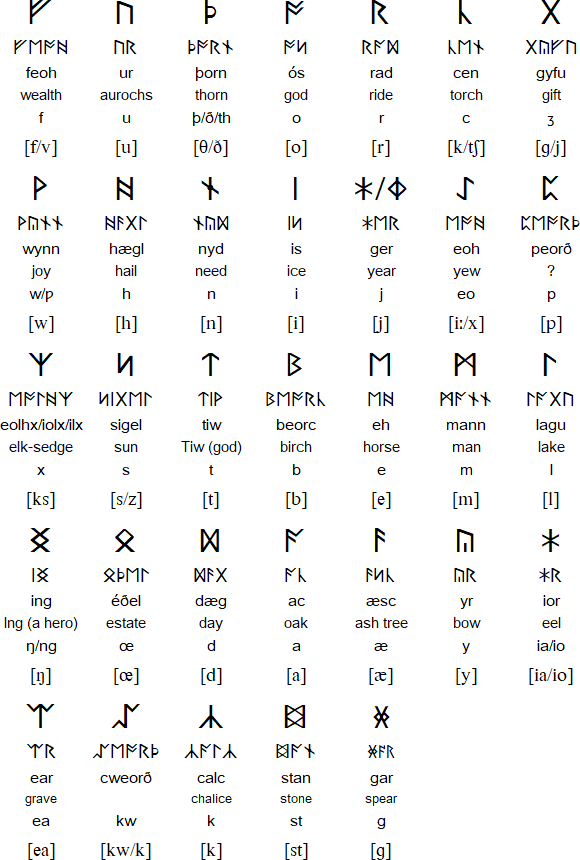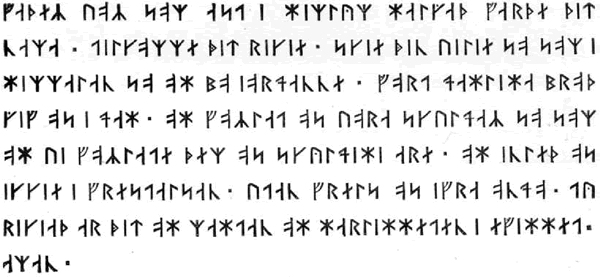And the Germanic runna, runic script. A common hypothesis posits an origin someplace in southern Europe, usually the Etruscans or Latins (which is odd because the runes are acknowledged as developing independently from alphabetic writing), which was carried north by migrating Germanic tribes during the Migration Period:
Runic alphabet
Origin
Little is known about the origins of the Runic alphabet, which is traditionally known as futhark after the first six letters. In Old Norse the word rune means 'letter', 'text' or 'inscription'. The word also means 'mystery' or 'secret' in Old Germanic languages and runes had a important role in ritual and magic.
Here are some theories about the origins of runes:
The earliest known Runic inscriptions date from the 1st century AD, but the vast majority of Runic inscriptions date from the 11th century. Runic inscriptions have been found throughout Europe from the Balkans to Germany, Scandinavia and the British Isles.
- The alphabet was probably created independently rather than evolving from another alphabet.
- Runic writing was probably first used in southern Europe and was carried north by Germanic tribes.
- The Runic alphabet is thought to have been modelled on the Latin and/or Etruscan alphabet.
Notable features
Types of runic inscriptions include:
- The direction of writing in early Runic inscriptions is variable. Later they settled down into a left to right pattern
- Word divisions were not generally recognised in Runic writing, although one or more dots were occasionally used for this function.
There are a number of different versions of the Runic alphabet including:
- 'Kilroy was here' type inscriptions on cliff walls, large rocks and buildings
- grave stone inscriptions, often with who carved the runes and who was buried, and also who made sure the stone was raised. (Later grave slabs or stone coffins were sometimes inscribed with Christian texts carved in runes)
- religious/magic inscriptions: prayers and curses, formulas on charms, etc.
- inscriptions related to trade and politics: There are many examples of trade communication: stock orders and descriptions, excuses for not having payed on time, trade name tags for bags or cases of produce, etc. The trade inscriptions are often carved on wooden rune sticks. Political inscriptions are to do with matters of the law, historical figures state that they were somewhere hiding from the enemy, secret messages to do with the fighting of wars, etc.
- personal letters: love letters, greetings between friends, proposals, etc.
- rude messages, similar to modern graffiti or sms today
- Art and craft-signatures: Goldsmiths, blacksmiths, wood carvers, church builders, etc., often put their name on what they made. Objects also somtimes had names carved onto them – either the name of the object itself, or the name of the person who owned it.
Elder Futhark
- Elder Futhark
- Gothic Runes
- Anglo-Saxon Futhorc
- Younger Futhork
- Hungarian Runes (Székely Rovásírás)
- Turkic (Orkhon) Runes
- Cirth (Tolkien's Runic-like alphabet)
Elder Futhark is thought to be the oldest version of the Runic alphabet, and was used in the parts of Europe which were home to Germanic peoples, including Scandinavia. Other versions probably developed from it. The names of the letters are shown in Common Germanic, the reconstructed ancestor of all Germanic languages.

Notes
The letter k is also called kēnaz (torch) or kanō (skiff). The meaning of the letter name perþ is unknown.
Gothic runes
Gothic, an extinct east Germanic language, was originally written with a Runic alphabet about which little is known. One theory of the origins of runes is that they were invented by the Goths, but this is impossible to prove as very few inscriptions of writing in Gothic runes survive. These runes were replaced with a new alphabet in the 4th century AD.

Anglo-Saxon Futhorc
A number of extra letters were added to the Runic alphabet to write Anglo-Saxon/Old English. Runes were probably bought to Britain in the 5th century by the Angles, Saxons, Jutes and Frisians (collectively known as the Anglo-Saxons), and were used until about the 11th century.
Runic inscriptions are mostly found on jewellery, weapons, stones and other objects. Very few examples of Runic writing on manuscripts have survived.

Younger Futhork
Younger Futhork or "Normal Runes" gradually evolved Elder Futhark over a period of many years and stabilized by about 800 A.D., the beginning of the Viking Age. It was the main alphabet in Norway, Sweden and Denmark throughout the Viking Age, but was largely though not completely replaced by the Latin alphabet by about 1200 as a result of the conversion of most of Scandinavia to Christianity.
Three slightly different versions of the alphabet developed in Denmark, Sweden and Norway:
Danish Futhark

Swedish-Norwegian / Short-twig / Rök Runes

Norwegian Futhark

Gothenburg / Bohuslän Runes

Medieval (Latinised) Futhark
After the arrival of Christianity in Scandinaiva, the Runic alphabet was Latinised and was used occasionlly, mainly for decoration until 1850.

Thanks to Niklas Dougherty for some of the information on this page.
Sample text - Lord's Prayer in Old Norse (Runic alphabet - Futhark)

Transliteration
Faðer uor som ast i himlüm, halgað warðe þit nama. Tilkomme þit rikie. Skie þin uilie so som i himmalan so oh bo iordanne. Wort dahliha broð gif os i dah. Oh forlat os uora skuldar so som oh ui forlate þem os skuüldihi are. Oh inleð os ikkie i frestalsan utan frels os ifra ondo. Tü rikiað ar þit oh mahtan oh harlihheten i ewihhet. Aman.
Source: www.christusrex.org/www1/pater/JPN-norse-old.html
Source:
http://www.omniglot.com/writing/runic.htm


 LinkBack URL
LinkBack URL About LinkBacks
About LinkBacks




 Citar
Citar
Marcadores